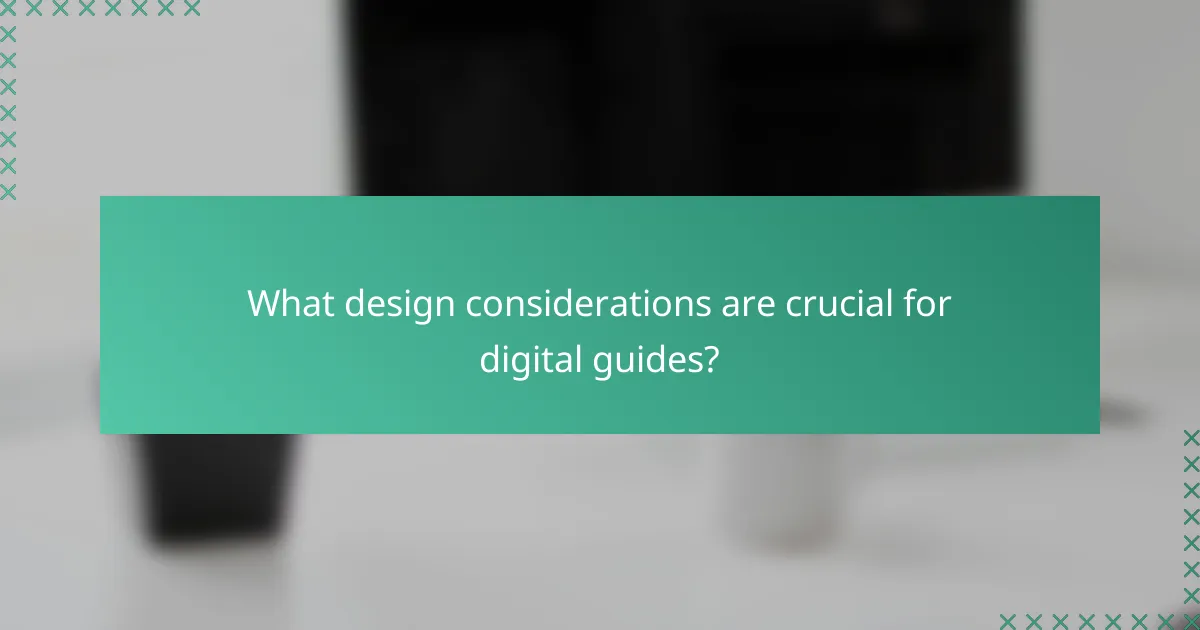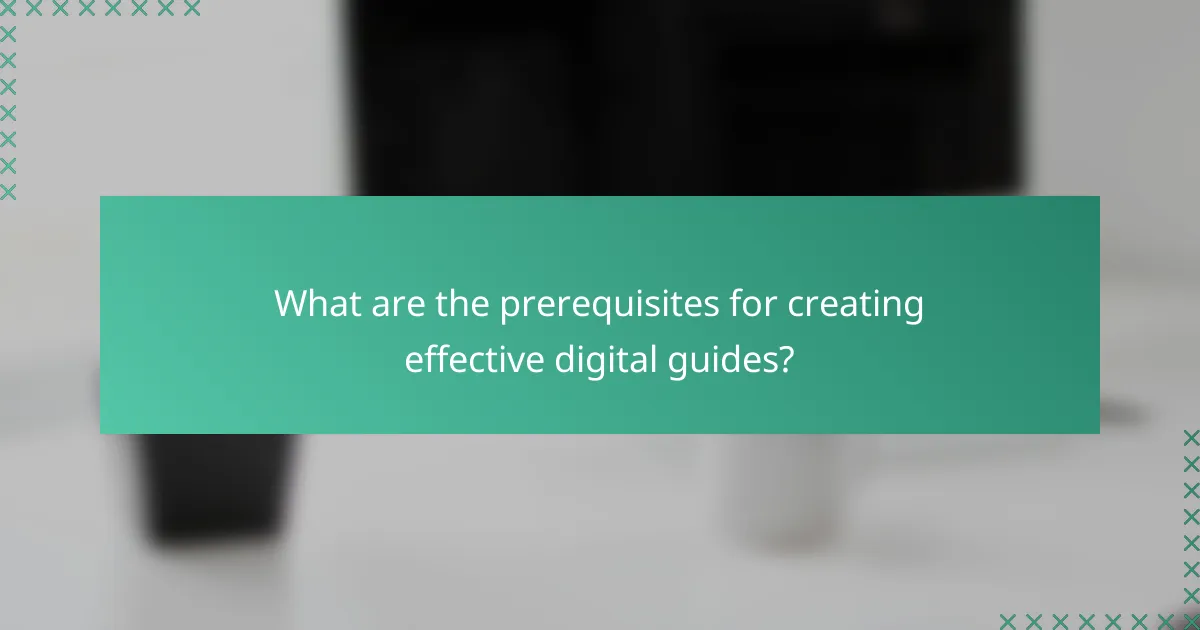Creating effective digital guides requires a thoughtful approach to research methods, writing styles, and design considerations. By employing qualitative, quantitative, or mixed-method research, you can gain valuable insights tailored to your audience’s needs. Selecting the appropriate writing style enhances clarity and engagement, while key design elements ensure usability and accessibility across devices. Together, these components contribute to the overall effectiveness of your digital guides.

What are effective research methods for digital guides?
Effective research methods for digital guides include qualitative, quantitative, and mixed-method approaches. Each method offers unique insights and can be tailored to specific project needs, ensuring comprehensive understanding and engagement with the target audience.
Qualitative research techniques
Qualitative research techniques focus on understanding user experiences and motivations through in-depth exploration. Methods such as interviews, focus groups, and content analysis allow researchers to gather rich, descriptive data that can inform the design and content of digital guides.
When using qualitative techniques, aim for a diverse participant pool to capture a range of perspectives. Keep discussions open-ended to encourage participants to share their thoughts freely, which can lead to unexpected insights.
Quantitative research methods
Quantitative research methods involve the collection and analysis of numerical data to identify patterns and trends. Techniques such as experiments, A/B testing, and analytics can provide measurable insights into user behavior and preferences.
To effectively implement quantitative methods, define clear objectives and metrics beforehand. Utilize tools like Google Analytics or survey platforms to gather data, ensuring that your sample size is large enough to produce statistically significant results.
Mixed-method approaches
Mixed-method approaches combine qualitative and quantitative research to provide a more comprehensive view of user needs. This method allows for the validation of qualitative findings with quantitative data, enhancing the overall reliability of the research.
When using mixed methods, start with qualitative research to explore user experiences, followed by quantitative methods to test hypotheses derived from those insights. This approach can help in creating more targeted and effective digital guides.
Case study analysis
Case study analysis involves an in-depth examination of specific instances or examples relevant to your digital guide’s topic. This method can highlight best practices, challenges, and solutions that have been effective in similar contexts.
To conduct a case study, select examples that are representative of your target audience. Analyze the outcomes and lessons learned, and consider how these insights can be applied to your own project.
Surveys and questionnaires
Surveys and questionnaires are structured tools for collecting data from a larger audience. They can help gauge user preferences, satisfaction, and needs, making them invaluable for shaping digital guides.
When designing surveys, keep questions clear and concise, and use a mix of open-ended and closed questions for richer data. Aim for a completion time of 5-10 minutes to encourage higher response rates, and consider offering incentives to boost participation.

How to choose a writing style for digital guides?
Selecting a writing style for digital guides involves understanding your audience and the purpose of the content. Different styles serve various functions, from informing to persuading, and choosing the right one enhances clarity and engagement.
Descriptive writing style
The descriptive writing style focuses on providing detailed information about a subject, using vivid language to paint a picture for the reader. This style is ideal for guides that aim to explain concepts, processes, or products in depth.
When using a descriptive style, incorporate sensory details and examples to help readers visualize the content. For instance, instead of saying “the software is user-friendly,” you might describe how intuitive the interface is, allowing users to navigate effortlessly.
Persuasive writing style
The persuasive writing style aims to convince the reader to adopt a particular viewpoint or take action. It is effective in marketing materials or guides that promote a product or service.
To employ this style, use strong arguments, emotional appeals, and calls to action. For example, you might highlight the benefits of a product, such as saving time or money, and conclude with a compelling invitation to purchase or sign up.
Technical writing style
The technical writing style is characterized by clarity and precision, often used in manuals, instructions, or documentation. This style is essential for conveying complex information in a straightforward manner.
When writing technically, use clear headings, bullet points, and straightforward language. Avoid jargon unless necessary, and provide definitions or explanations for any complex terms. For example, a user manual for software should include step-by-step instructions with screenshots to guide users effectively.
Narrative writing style
The narrative writing style tells a story, making it engaging and relatable for the reader. This style can be particularly effective in guides that aim to inspire or motivate, such as personal development or travel guides.
To use a narrative style, incorporate anecdotes, personal experiences, or case studies. For instance, sharing a story about overcoming challenges can resonate with readers and encourage them to take action based on the lessons learned.

What design considerations are crucial for digital guides?
Key design considerations for digital guides include user experience, visual hierarchy, responsive design, and accessibility standards. These elements ensure that guides are effective, engaging, and usable across various devices and by diverse audiences.
User experience (UX) design
User experience design focuses on creating a seamless interaction between the user and the digital guide. This involves understanding user needs, preferences, and behaviors to enhance satisfaction and usability.
Consider conducting user testing to gather feedback on navigation, layout, and content clarity. Tools like wireframes and prototypes can help visualize the user journey and identify potential pain points before finalizing the design.
Visual hierarchy principles
Visual hierarchy principles guide users’ attention to the most important elements of a digital guide. By using size, color, contrast, and spacing effectively, you can create a clear path for users to follow.
For example, larger headings can denote section titles, while bullet points can break down complex information into digestible parts. Consistent use of fonts and colors also aids in establishing a cohesive look that enhances readability.
Responsive design techniques
Responsive design techniques ensure that digital guides function well on various devices, from desktops to smartphones. This adaptability is crucial as users increasingly access content on different screen sizes.
Using flexible grids, fluid images, and CSS media queries allows the layout to adjust dynamically. Testing across multiple devices and browsers is essential to ensure a consistent experience for all users.
Accessibility standards
Accessibility standards aim to make digital guides usable for individuals with disabilities. Adhering to guidelines such as the Web Content Accessibility Guidelines (WCAG) helps ensure that content is perceivable, operable, and understandable.
Incorporate features like alternative text for images, keyboard navigation, and sufficient color contrast. Regularly reviewing and updating your content for compliance can significantly enhance inclusivity and reach a broader audience.

What are the prerequisites for creating effective digital guides?
Creating effective digital guides requires a clear understanding of your audience and well-defined objectives. These prerequisites ensure that the content is relevant, engaging, and serves its intended purpose.
Understanding target audience
Identifying your target audience is crucial for tailoring content that resonates with them. Consider factors such as demographics, interests, and knowledge levels to create a guide that meets their needs.
Conduct surveys or interviews to gather insights about your audience. This information can help you determine the appropriate tone, complexity, and format for your digital guide.
Defining guide objectives
Clearly defined objectives guide the content and structure of your digital guide. Establish what you want to achieve, whether it’s educating users, providing step-by-step instructions, or promoting a product.
Use the SMART criteria—Specific, Measurable, Achievable, Relevant, and Time-bound—to formulate your objectives. For example, instead of saying “increase user engagement,” specify “increase user engagement by 20% over the next three months.”

How to evaluate the effectiveness of digital guides?
To evaluate the effectiveness of digital guides, focus on user engagement, comprehension, and satisfaction. Gathering data through various methods can help identify strengths and areas for improvement.
User feedback collection
User feedback collection is essential for assessing how well a digital guide meets its objectives. This can be achieved through surveys, interviews, and usability testing, allowing users to share their experiences and suggestions directly.
Consider implementing short surveys at the end of the guide or after specific sections to gauge user satisfaction. Aim for a response rate of at least 10-20% to ensure your data is representative. Open-ended questions can provide qualitative insights, while rating scales can quantify user sentiment.
Additionally, usability testing sessions can reveal how users interact with the guide. Observing users as they navigate the content helps identify any confusing elements or areas where users struggle. This direct observation is invaluable for making informed adjustments to enhance the guide’s effectiveness.
